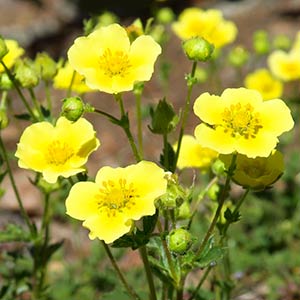Drymocallis deseretica
Drymocallis pseudorupestris
Deseret drymocallis or wood beauty
cliff drymocallis, cliff woodbeauty, false rock loving cinquefoil, Rocky Mountain sticky cinquefoil
short.
elongate.
± tufted, (1.5–)2.5–6(–6.5) dm;
base 2–3(–4) diam., sparsely to densely septate-glandular.
openly tufted to loosely spaced, (0.3–)0.6–4 dm;
base 1–3 mm diam., ± densely septate-glandular.
sparsely hairy;
basal (5–)7–20 cm, leaflet pairs (2–)3;
terminal leaflet broadly obovate to rhombic, (1.5–)2–4 × (1–)1.5–3 cm, teeth single or double, 5–9 per side, apex acute to obtuse;
cauline 1–2, well developed, leaflet pairs 2–3.
glabrate or sparsely to ± densely hairy;
basal (2–)3–16 cm, leaflet pairs (2–)3–4(–5);
terminal leaflet broadly obovate-cuneate to flabellate, 0.2–3(–4) × 0.5–3 cm, teeth single or double, 2–15 per side, apex usually rounded to truncate, sometimes obtuse;
cauline 0–2, reduced, leaflet pairs 2–3.
3–15(–20)-flowered, leafy, ± compact, (1/6–)1/5–1/3(–1/2) of stem, narrow, branch angles 10–20°.
2–40-flowered, not or ± leafy, open, 1/6–3/4(–4/5) of stem, ± wide, branch angles (10–)20–40(–50)°.
2–15 (proximal to 20) mm, predominantly short-hairy, often velutinous, not or sparsely to moderately septate-glandular.
3–20 (proximal to 40) mm, not or sparsely to moderately short-hairy, predominantly septate-glandular.
opening widely;
epicalyx bractlets linear to lanceolate or narrowly elliptic, (2.5–)3–8 × 0.5–2(–3) mm;
sepals spreading, (5–)6–12(–15) mm, apex usually acute, sometimes obtuse;
petals rarely overlapping, spreading, cream-white to light yellow, narrowly to broadly obovate, (4–)6–10 × (2.5–)3.5–6(–7) mm, usually shorter than sepals;
filaments 1–3 mm, anthers 0.8–1 mm;
styles very thickened, 1 mm.
opening widely;
epicalyx bractlets linear to elliptic, 2–6 × 1–2 mm;
sepals spreading, 4–7(–9) mm, apex acute to obtuse, apiculate;
petals overlapping or not, spreading, cream-white to pale yellow (red-tinged in var. crumiana), narrowly to broadly obovate, 4–12 × 3–11 mm, longer than sepals;
filaments 1–4 mm, anthers 0.7–1.2 mm;
styles thickened, 1–1.5 mm.
light brown, 1.2–1.5 mm.
light brown, 1 mm.
Drymocallis deseretica
Drymocallis pseudorupestris
Drymocallis deseretica is common in the Wasatch and western Uintah mountains of northern and central Utah, where it has usually been treated as Potentilla glandulosa var. intermedia (= D. glabrata) or P. glandulosa var. pseudorupestris (= D. pseudorupestris var. saxicola). It differs from both taxa in its more compact inflorescences, predominantly short-hairy pedicels, and sepals that conspicuously enlarge in fruit, which create a distinctive aspect. Comparable plants with shorter, obtuse sepals occur in the Raft River Mountains; their optimal placement remains to be determined. Inclusion of Wyoming in the species range is based on Goodding 1993 (UT) from Bridger Peak, Carbon County. Drymocallis deseretica intergrades with D. glabrata to the north and D. arizonica to the south, with the exact range yet to be determined.
(Discussion copyrighted by Flora of North America; reprinted with permission.)
Varieties 3 (3 in the flora).
Drymocallis pseudorupestris occurs from Alberta and Washington to California and Utah, mostly in montane habitats; it is the species most often associated with rocky habitats, including talus slopes, for which its relatively elongate caudex branches are an obvious adaptation. Vestiture is dominated by abundant septate glands on stems and in the inflorescences. Except for var. pseudorupestris, which occurs only in the northeastern part of the species range, plants are relatively short, usually less than 2.5 dm. Three intergrading varieties accommodate the extremes at the northeastern and southern ends of the range.
(Discussion copyrighted by Flora of North America; reprinted with permission.)
1. Stems (1–)2–4 dm, bases (1.5–)2–3 mm diam.; basal leaves (4–)7–16 cm; terminal leaflets (1–)2–3(–4) cm, teeth usually double, (5–)8–15 per side; flowers (5–)10–40; petals 6–12 × 5–11 mm, widely overlapping; filaments 2–4 mm. | var. pseudorupestris |
1. Stems (0.3–)0.6–2.5 dm, bases 1–2(–3) mm diam.; basal leaves (2–)3–9(–15) cm; terminal leaflets 0.2–2(–4) cm, teeth single or ± double, 2–8(–12) per side; flowers 2–12(–20); petals 4–8(–9) × 3–6(–8) mm, not or ± overlapping; filaments 1–2.5(–3) mm | → 2 |
2. Basal leaves: leaflet pairs (2–)3(–4); hypanthia and sepals not bristly or bristles less than 1 mm; short hairs sparse to moderately abundant on stems and pedicels (sometimes absent); styles usually golden brown, rarely reddish. | var. saxicola |
2. Basal leaves: leaflet pairs 3–4(–5); hypanthia and sepals prominently bristly, bristles 1–1.5 mm; short hairs absent or sparse on stems and pedicels; styles usually dark red, rarely golden brown. | var. crumiana |
- Local floras:
BC,
CA,
OR
- Local Web sites:
CalFlora,
CalPhotos,
Flora NW,
PNW Herbaria
WildflowerSearch
iNaturalist (observations)
USDA Plants Database
- LBJ Wildflower Center
- SEINet
- Plants of the World Online
- Encyclopedia of Life
- Wikipedia
- Google Image Search
